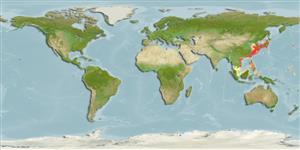Common names from other countries
Teleostei (teleosts) >
Perciformes/Scorpaenoidei (Scorpionfishes) >
Triglidae (Searobins) > Triglinae
Etymology: Chelidonichthys: Greek, chelidon, -onos = swift, as black as a swift + Greek, ichthys = fish (Ref. 45335).
More on author: McClelland.
Environment: milieu / climate zone / depth range / distribution range
Ecology
Marine; demersal; depth range 25 - 615 m (Ref. 11230). Tropical
Northwest Pacific: southern Hokkaido, Japan southward to the South China Sea.
Size / Weight / Age
Maturity: Lm ? range ? - ? cm
Max length : 40.0 cm TL male/unsexed; (Ref. 559); max. published weight: 950.00 g (Ref. 40637)
Dorsal
soft rays
(total): 15-17;
Anal
soft rays: 15 - 17. Lower half of the inner pectoral fin with scattered numerous pale spots (bluish in life, white or pale in preserved specimens); black blotch appears occasionally on lower inner part of pectoral fin.
Found in the tropical to warm temperate areas (Ref. 9771), in sandy or sandy mud bottom (Ref. 11230).
Life cycle and mating behavior
Maturity | Reproduction | Spawning | Eggs | Fecundity | Larvae
Richards, W.J., 1999. Triglidae. Gurnards, sea robins, armored gurnards, and armored sea robins. p. 2359-2363. In K.E. Carpenter and V.H. Niem (eds.) FAO species identification guide for fishery purposes. The living marine resources of the WCP. Vol. 4. Bony fishes part 2 (Mugilidae to Carangidae). FAO, Rome. (Ref. 9771)
IUCN Red List Status (Ref. 130435)
CITES (Ref. 128078)
Not Evaluated
Threat to humans
Harmless
Human uses
Fisheries: commercial
More information
Common namesSynonymsMetabolismPredatorsEcotoxicologyReproductionMaturitySpawningFecundityEggsEgg development
ReferencesAquacultureAquaculture profileStrainsGeneticsElectrophoresesHeritabilityDiseasesProcessingMass conversion
Tools
Special reports
Download XML
Internet sources
Estimates based on models
Preferred temperature (Ref.
115969): 6.1 - 23.1, mean 17.9 (based on 261 cells).
Phylogenetic diversity index (Ref.
82804): PD
50 = 0.5010 [Uniqueness, from 0.5 = low to 2.0 = high].
Bayesian length-weight: a=0.00692 (0.00459 - 0.01043), b=3.06 (2.94 - 3.18), in cm Total Length, based on LWR estimates for this species & (Sub)family-body (Ref.
93245).
Trophic level (Ref.
69278): 3.9 ±0.7 se; based on diet studies.
Resilience (Ref.
120179): Medium, minimum population doubling time 1.4 - 4.4 years (Preliminary K or Fecundity.).
Fishing Vulnerability (Ref.
59153): Low to moderate vulnerability (30 of 100).
